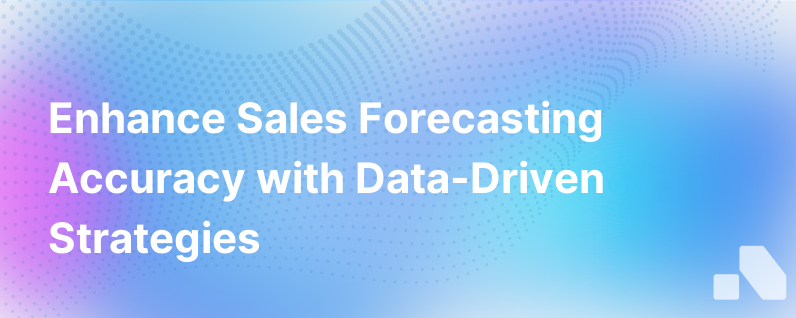
Sales forecasting is both an art and a science, offering businesses a glimpse into their financial future. Getting it right means you can plan with confidence, align your teams, and lay the groundwork for sustained growth. However, as any experienced salesperson might tell you, accurate sales forecasting often feels like a pursuit of elusive accuracy. The key? Your data.
While traditional forecasting methods have leaned on intuition and past experience, the modern sales landscape demands more precision. Putting your data to work can mean the difference between a forecast based on educated guesses and one grounded in reality.
Data Is King
Firstly, it’s important to establish that your sales data holds immense value. It’s a record of past performance, a treasure trove of trends, and a harbinger of potential opportunities and pitfalls. Data-driven forecasting uses quantitative methods to predict future sales, utilizing historical sales data, seasonal trends, industry benchmarks, and more.
Why Sales Forecasts Falter Without Good Data
Many forecasts miss the mark due to reliance on gut feelings and over-optimistic assumptions. Here's why forecasts falter without data:
- Human Bias: We're inherently optimistic about deals in our pipeline. Data doesn't have an ego to bruise or a quota to meet—it tells it like it is.
- Complex Sales Processes: Modern sales involve multiple touchpoints and stakeholders. Without hard data, it's easy to misjudge where a deal truly stands.
- Evolving Buyer Behavior: Today's buyers are better informed and more independent than ever, making it harder to manually predict their decision-making processes.
- Market Volatility: Economic factors, industry disruptions, and competitive moves can all skew sales outcomes. Real-time data helps anticipate and adapt to these changes.
Leveraging Data for Sharper Forecasts
Here’s how to harness data for more accurate sales forecasting:
Historical Data Analysis
The foundation of any good forecast is a deep dive into historical sales data. Look for patterns, trends, and anomalies. Better yet, use predictive analytics tools that can process vast volumes of historical data to identify factors that consistently lead to won deals or lost opportunities.
Pipeline Predictability
Each stage of your pipeline has a conversion rate. For example, the jump from prospect to qualified lead or from a demonstration to a proposal. Measure these conversion rates over time to understand the predictability of your pipeline. Your CRM might be able to do this automatically or may require deeper analysis using sales analytics tools.
Deal Scoring
Not all leads are created equal. Assign scores to deals based on various data points (like deal size, lead source, and buyer interaction) to estimate the likelihood of closing. This weighted forecasting approach refines your predictions, making them more grounded in reality.
Sales Cycle Length
Understanding the typical length of your sales cycle by segmenting your data (e.g., by industry, deal size) can help anticipate the time it takes for revenue to hit. This insight can be critical for managing cash flow and resources.
External Data Factors
Incorporate external data into your forecast, such as market trends, economic indicators, and competitor activity. Tools that offer real-time market data can significantly enhance the accuracy of your forecasting.
Sales Activity Data
Go beyond just results. Look at sales activity data like calls made, emails sent, meetings booked, and demo completion rates. This activity data can be a leading indicator of sales success and help forecast future performance.
Machine Learning and AI
Advanced technology now allows for the implementation of machine learning algorithms, which can process complex data sets and continuously improve forecasts based on new information. Implementing a tool powered by AI, like Aomni, can help provide a more nuanced, continually updated forecast.
Best Practices for Data-Driven Sales Forecasting
To ensure your data works effectively for your forecasts, keep these best practices in mind:
- Data Hygiene: Regularly clean and maintain your data. Outdated, duplicated, or incomplete data can dramatically skew forecasts.
- Continuous Training: Sales teams should be trained to understand the importance of accurate data entry and consistent CRM use.
- Regular Revisions: Forecasting isn't a one-and-done activity. Regularly revisit and revise your forecasts as new sales data comes in.
- Integrations: Make sure your sales tools integrate seamlessly, ensuring data silos are eliminated and a complete data picture is constructed.
- Sales and Marketing Alignment: Ensure that both sales and marketing are working from the same data set and communicating changes or updates that could affect forecasting.
How Aomni Can Help
At the end of it all, technology comes in to tie these practices together. A platform like Aomni leverages AI to digest and interpret vast amounts of data for more accurate sales forecasting. It takes the heavy lifting off your team's shoulders, creating a systemized, data-driven process that minimizes errors and maximizes precision.
Conclusion
Accurate sales forecasting is more attainable than ever with advances in technology and a stronger emphasis on data across the sales landscape. By putting your sales data to work, you can elevate your forecasting from educated guesses to strategic planning tools. The result? A more predictable future that empowers business leaders to make informed decisions for their company's success.